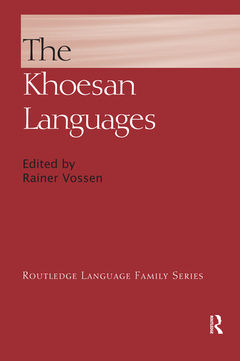The Khoesan Languages Routledge Language Family Series
Coordonnateur : Vossen Rainer

The Routledge Language Family series is aimed at undergraduates and postgraduates of linguistics and language, and those with an interest in historical linguistics, linguistic anthropology and language development.
According to a widely accepted hypothesis, the Khoesan languages represent the smallest of the four language phyla in Africa, geographically distributed mainly in Botswana and Namibia. Today, only 30 or so Khoesan languages may still exist, with about 300,000 native speakers. In other words, most Khoesan languages were already extinct before a sound scholarly interest in them could begin to develop.
Drawing together a distinguished group of international experts, with much of the material taken from data collected by the authors? own field work, this volumepresents descriptive, typological, historical-comparative and sociolinguistic material on Khoesan. The Khoesan Languages contains eight sections: an introduction, an overview of genetic relationships, a typological survey and profile of Khoesan, four chapters covering core linguistic areas of Khoesan phonetics and phonology, tonology, morphology and syntax, and a final chapter tackling major issues in Khoesan sociolinguistics, as well as discussions of language contact.
Comprehensive and scholarly, yet also lucid in its coverage of a broad range of languages, dialects and sub-groups, this unprecedented and original work represents the current state of Khoesan linguistics.
Chapter 1: Introduction.Rainer Vossen 1. General background 2. Typological characteristics. 3. The intended audience 4. The contents 5. Geographical coverage Chapter 2: Genetic relationships: an overview of the evidence Henry Honken1. Introduction 2. Previous work in the field 3. Agreements and disagreements 4. South African Khoesan 5. East African Khoesan 6. For and against Chapter 3: Typology Tom Güldemann 1. Introduction 2. Morphosyntax 3. Phonetics and phonology 4. Toward a typological profile of Khoesan Chapter 4: Phonetics and phonology 1. Hadza Bonny Sands 2. Sandawe Edward D.Elderkin 3. South African Khoesan 3.1. Northern Khoesan Amanda Miller 3.2. Central Khoesan 3.2.1. Namibian Khoekhoe and !Gora Wilfrid H.G. Haacke 3.2.2. Hai§om Thomas Widlockl 3.2.3. Kxoe subgroup Rainer Vossen 3.2.4. Naro Hessel Visser 3.2.5. §Gana subgroup Hirosi Nakagawa 3.2.6. Shua subgroup Rainer Vossen 3.2.7. Tshwa subgroup Rainer Vossen 3.3. Southern Khoesan (Tuu languages) Tom Güldemann 3.4. Eastern =Hoan Henry HJonken 3.5. Kwadi Tom GüldemannChapter 5: Tonology 1. Hadza Bonny Sands 2. Sandawe Edward D. Elderkin 3. South African Khoesan 3.1. Northern Khoesan Amanda Miller 3.2. Central Khoesan 3.2.1. Namibian Khoekhoe Wilfred H.G. Haacke 3.2.2. Kxoe subgroup: Khwe, §Ani Rainer Vossen 3.2.3. Naro Hessel Visser 3.2.4. §Gana subgroup: "Gui Hirosi Nakagawa 3.2.5. Shua subgroup: Cara, Deti Rainer Vossen 3.2.6. Tshwa subgroup Rainer Vossen 3.3. Southern Khoesan: !Xóõ Amanda Miller 3.4. Eastern =Hoan Henry HonkenChapter 6: Morphology 1. Hadza Bonny Sands 2. Sandawe Edward D. Elderkin 3. South African Khoesan 3.1. Northern Khoesan Bernd Heine and Christa König 3.2. Central Khoesan 3.2.1. Namibian Khoekhoe Wilfrid H.G. Haacke 3.2.2 !.Gora Wilfrid H.G. Haacke 3.2.3. Hai§om Thomas Widlok 3.2.4. Kxoe subgroup Rainer Vossen and Mathias Schladt 3.2.5. Naro Hessel Visser 3.2.6. §Gana subgroup Rainer Vossen 3.2.7. Shua subgroup Rainer Vossen 3.2.8. Tshwa subgroup Rainer Vossen 3.3. Southern Khoesan (Tuu languages) Tom Güldemann 3.4 Eastern =Hoan. Henry HonkenChapter 7: Syntax 1. Hadza Bonny Sands 2. Sandawe Edward D. Elderkin 3. South African Khoesan 3.1. Northern Khoesan: !Xun Bernd Heine and Christa König 3.2. Central Khoesan 3.2.1. Namibian Khoekhoe Wilfrid H.G. Haacke 3.2.2. !Gora Wilfrid H.G. Haacke 3.2.3. Hai§om Thomas Wodlok 3.2.4. Kxoe subgroup: Khwe Christa Killan-Hatz 3.2.5. Naro Hessel Visser 3.2.6. §Gana subgroup: "Gui Hirosi Nakagawa 3.2.7. Shua subgroup Rainer Vossen 3.2.8. Tshwa subgroup Rainer Vossen 3.3. Southern Khoesan (Tuu languages) Tom Güldemann 3.4. Eastern =Hoan Henry Honken 3.5. Kwadi Tom Güldemann Chapter 8: Language contact and sociolinguistics 1. The impact of Khoesan on southern Bantu J.A. Louw 2. BantuKhoesan language contacts in northern Botswana Gabriele Sommer 3. Traces of Bantu-Khoesan interaction in Manyo (Kavango Bantu, Namibia) Wilhelm J.G. Möhlig 4. South African Khoekhoe in contact with Dutch/Afrikaans Hans den Besten 5. Contact-induced change between Khoekhoe and Afrikaans Wilfrid H.G. Haacke 6. Namibian Ju"’hoansi in contact with speakers of Afrikaans Amanda Miller 7. Hai§om language contact Thomas Widlok 8. Khoesan-internal contacts Tom Güldemann 9. Extinct Khoesan languages of Eastern Africa Christopher Ehret 10. The sociolinguistic situation of Khoesan languages today Gabriele Sommer and Thomas Widlok Bibliography Language index Subject index
Rainer Vossen is a University Professor and Executive Director of the Institute of African Studies at the University of Frankfurt upon Main, Germany.
Date de parution : 06-2020
15.6x23.4 cm
Date de parution : 02-2013
15.6x23.4 cm
Thèmes de The Khoesan Languages :
Mots-clés :
The Khoesan Languages; The Khoisan Languages; Khoesan language group; Khoesan language family; Khoisan language family; Khoesaan languages; Rainer Vossen; Khoesan; Khoisan; Khoesaan; Khoesan linguistics; Khoisan linguistics; African languages; African linguistics; Khoesan Languages; African studies; OLF; Young Man; IRU; RI WKH; Khoe Languages; OHRI; SVO; LLL; Click Replacement; Sov Word Order; Click Consonants; Alveolar Click; North Western Botswana; Vice Versa; Vossen 1997a; SC; Click Words; Khoe Family; Past Tenses; Glottal Stop; Glottal Plosive; Velar Fricative; Bantu Languages; North Eastern Uganda



